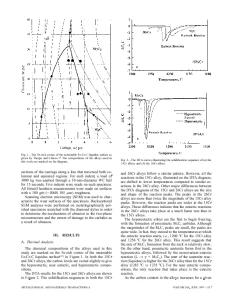Controlled graphitization as a potential option for improving wear resistance of unalloyed white irons
- PDF / 2,026,572 Bytes
- 13 Pages / 612 x 792 pts (letter) Page_size
- 22 Downloads / 275 Views
I.
INTRODUCTION
White cast irons are mostly used in applications where resistance to wear is the main requirement. This is attributed to their high hardness.[1] In plain carbon white irons, hardness increases with the carbon content. However, if carbon content exceeds 4.3 pct, the shock resistance is lowered because of the formation of free cementite. Hence, carbon is generally restricted to 3.0 to 3.5 pct. This restricts the maximum attainable hardness. For attaining a still higher level of hardness/wear resistance, the conventionally employed option comprises a combination of alloying[1–10] and heat treatment. The processing involved is aimed at altering the base microstructure from (1) pearlite to bainite/martensite, and (2) cementite to alloyed carbides. Shock resistance is improved by attaining discontinuous carbides in place of net work carbides. Although a combination of alloying and heat treating is often employed, it may not be possible to justify their use, either singly or in combination, based on cost considerations, especially when the product size is very small and it is moderately priced. In such situations, it would be prudent to look for innovative yet unconventional options not necessarily depending upon alloying. The aim of this article is to highlight how an unconvenA.K. PATWARDHAN, Professor, and S. KUMAR, Lecturer, are with the Department of Metallurgical and Materials Engineering, University of Roorkee, Roorkee 247667, India. PRAKASH SINGH, Works Manager, is with Grey Iron Foundry, Ordnance Factory, Jabalpur, India. Manuscript submitted October 18, 1994. METALLURGICAL AND MATERIALS TRANSACTIONS A
tional option, comprising controlled graphitization, can be usefully employed to improve the wear resistance of white irons. II.
EXPERIMENTAL PROCEDURE
Cylindrical pebbles (cylpebs), made available by M/s ACC Ltd. (Mumbai, India), were used in the present investigation. They were made by pouring molten metal obtained from a cupola into small steel molds mounted on a conveyor belt system. The molds were continuously spray cooled by water to ensure that the product was cast white. The average composition of the cylpebs is given in Table I. Heat treatments comprised holding at 800 7C, 850 7C, 900 7C, and 950 7C for 30, 60, 90, 120, and 180 minutes followed by oil quenching. Cylindrical specimens of a constant diameter were prepared from the as-cast and heat-treated cylpebs. Hardness was measured on a Rockwell hardness tester on a C scale. Microstructural examination was carried out both in the etched and unetched conditions on Reichert Metavert-368 optical and PHILIPS*-501 scanning electron microscopes. *PHILIPS is a trademark of Philips Electronic Instruments Corp., Mahwah, NJ.
Resistance to abrasive wear was measured in a dry condition using the pin-on-disc method. The rig fabricated (Figure 1) comprised a bonded alumina grinding wheel mounted horizontally to a polishing machine. A specimen located at a preset distance from the center of the wheel was made to abrade against the wheel under a con










